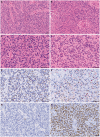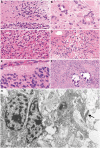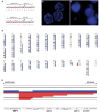Childhood supratentorial ependymomas with YAP1-MAMLD1 fusion: an entity with characteristic clinical, radiological, cytogenetic and histopathological features
- PMID: 30246434
- PMCID: PMC7379249
- DOI: 10.1111/bpa.12659
Childhood supratentorial ependymomas with YAP1-MAMLD1 fusion: an entity with characteristic clinical, radiological, cytogenetic and histopathological features
Abstract
Ependymoma with YAP1-MAMLD1 fusion is a rare, recently described supratentorial neoplasm of childhood, with few cases published so far. We report on 15 pediatric patients with ependymomas carrying YAP1-MAMLD1 fusions, with their characteristic histopathology, immunophenotype and molecular/cytogenetic, radiological and clinical features. The YAP1-MAMLD1 fusion was documented by RT-PCR/Sanger sequencing, and tumor genomes were studied by molecular inversion probe (MIP) analysis. Significant copy number alterations were identified by GISTIC (Genomic Identification of Significant Targets in Cancer) analysis. All cases showed similar histopathological features including areas of high cellularity, presence of perivascular pseudo-rosettes, small to medium-sized nuclei with characteristic granular chromatin and strikingly abundant cells with dot-like cytoplasmic expression of epithelial membrane antigen. Eleven cases presented features of anaplasia, corresponding to WHO grade III. MRI showed large supratentorial multinodular tumors with cystic components, heterogeneous contrast enhancement, located in the ventricular or periventricular region. One of two variants of YAP1-MAMLD1 fusions was detected in all cases. The MIP genome profiles showed balanced profiles, with focal alterations of the YAP1 locus at 11q22.1-11q21.2 (7/14), MAMLD1 locus (Xp28) (10/14) and losses of chromosome arm 22q (5/14). Most patients were female (13/15) and younger than 3 years at diagnosis (12/15; median age, 8.2 months). Apart from one patient who died during surgery, all patients are alive without evidence of disease progression after receiving different treatment protocols, three without postoperative further treatment (median follow-up, 4.84 years). In this to date, largest series of ependymomas with YAP1-MAMLD1 fusions we show that they harbor characteristic histopathological, cytogenetic and imaging features, occur mostly in young girls under 3 years and are associated with good outcome. Therefore, this genetically defined neoplasm should be considered a distinct disease entity. The diagnosis should be confirmed by demonstration of the specific fusion. Further studies on large collaborative series are warranted to confirm our findings.
Keywords: YAP1-MAMLD1 fusion; childhood; ependymoma; supratentorial.
© 2018 The Authors. Brain Pathology published by John Wiley & Sons Ltd on behalf of International Society of Neuropathology.
Figures





References
-
- Bao Y, Hata Y, Ikeda M, Withanage K (2011) Mammalian Hippo pathway: from development to cancer and beyond. J Biochem (Tokyo) 149:361–379. - PubMed
-
- Figarella‐Branger D, Lechapt‐Zalcman E, Tabouret E, Jünger S, de Paula AM, Bouvier C et al (2016) Supratentorial clear cell ependymomas with branching capillaries demonstrate characteristic clinicopathological features and pathological activation of nuclear factor‐kappaB signaling. Neuro‐Oncol 18:919–927. - PMC - PubMed
-
- Fukami M, Wada Y, Okada M, Kato F, Katsumata N, Baba T et al (2008) Mastermind‐like domain‐containing 1 (MAMLD1 or CXorf6) transactivates the Hes3 promoter, augments testosterone production, and contains the SF1 target sequence. J Biol Chem 283:5525–5532. - PubMed
Publication types
MeSH terms
Substances
LinkOut - more resources
Full Text Sources
Other Literature Sources

